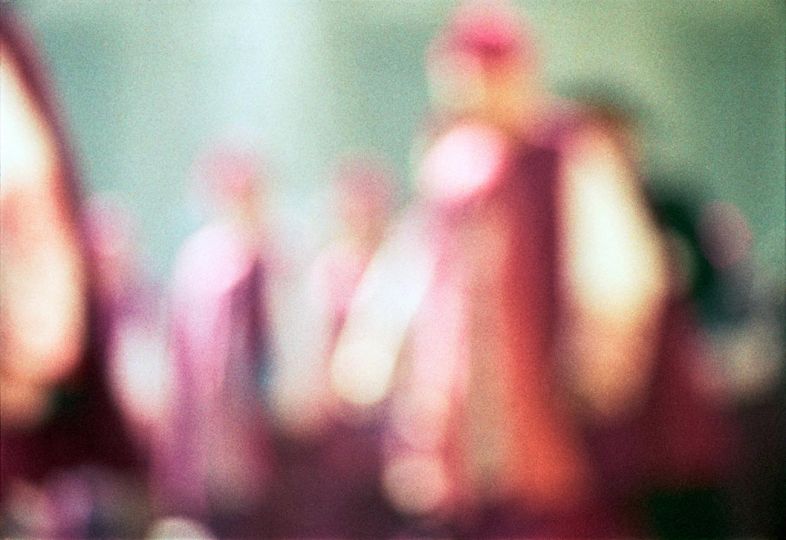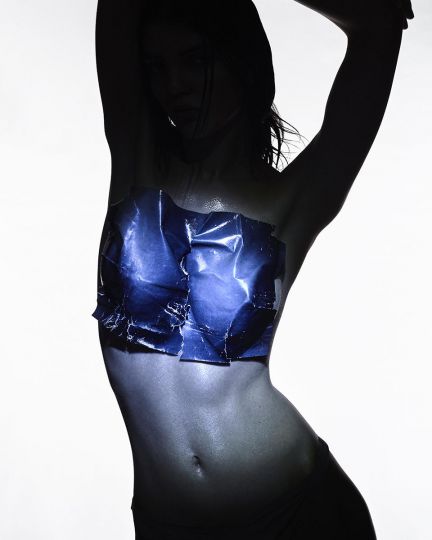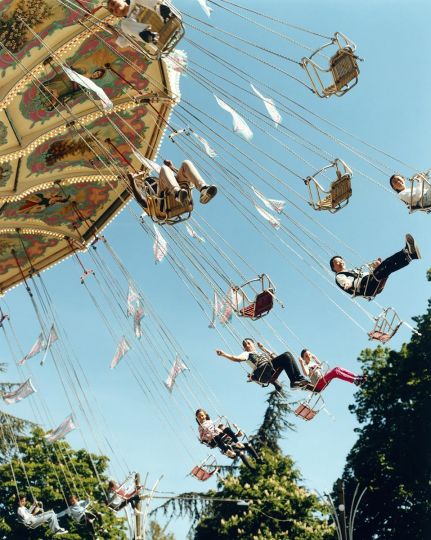This splendid place dedicated to the protean Hungarian artist presents the meeting of two great personalities, that of the artist Alexander Camaro with the German photographer Lothar Wolleh. We find there iconic portraits of the painter made with Hasselblad and savor a color facet of Wolleh that had remained in the semi-darkness.
Alexander Camaro (1901-1992), arms crossed, fishnet t-shirt, white pants and gazing away: this is how photographer Lothar Wolleh (1930-1979) chose to immortalize the visual artist, seated in front of his table folded back that we find intact today. He who lent his sharp eye to the great names of an entire era – Magritte, Baselitz, Richter, Niki de Saint Phalle and many others, met Camaro in Berlin in the sixties. If the two men had a mutual admiration for each other, they also shared light and shadow in their art as a reflection of their singular perceptions of the world.
This portrait – among a series of precise stagings of the visual artist orchestrated by Wolleh, Camaro subsequently appropriated it, armed with his grease pencils to create a work that embodies the meeting of two paths, the union of two universes. Alexander Camaro took the opportunity to accessorize himself with a top hat and a white bow tie, as if to transcribe an inner side that is elusive to the naked eye. And this is how the table transformed into a wheel becomes the gateway to his phantasmagorical universe.
Inspired in his early days by the expressionism he discovered with his early teacher Otto Mueller, Camaro never claimed any style. He did not like boxes and preferred to shape his artistic identity using the freedoms he had granted himself. The circus but also dance and theater have always been part of his life. For this enthusiast, painting was a transversal practice that allowed him to pay homage to interdisciplinary arts while erasing their borders.
On the other side of the camera, Lothar Wolleh, one of the greatest German portrait photographers of the time, and a precise way of photographing. An undisputed mastery of framing for this chiaroscuro acrobat. His apprehension of the photographic medium had been greatly marked by an event of his youth: six years of captivity in the mines of Siberia. Suspected of spying during the 1950s by the Russians, the young Berliner was sent to the penitentiary camp of Vorkuta – his art was forever imbued with this experience of captivity, this ultimate encounter with darkness.
The light is these large prints from the Second Ecumenical Council of the Vatican led by Pope John XXIII that Lothar Wolleh was commissioned to document during the three years, from 1962 to 1965. Blurry, grainy, the ecclesiastical outfits of the religious dazzle with their raspberry color against the immaculate walls. More than the moment, photographs show the symbolic significance of an event that marked the new life of the Catholic Church, in particular by using techniques such as superimposition. Wolleh manages here the time of his captures to undo the religion of its chains and leads it closer to its essence.
This reportage full of spirituality in both form and content is punctuated by works by Alexander Camaro, including the famous “Shadows of Light” which lends its name to the exhibition. Painting and photography then mirror each other and the real and its reverse intertwine in a beautiful dialogue.
“Shadows of Light” – Alexander Camaro and Lothar Wolleh at the Alexander & Renata Camaro Foundation until October 6, 2023.
The Foundation is organizing a round table on Wednesday 27 September at 7 p.m. in the presence of Matthias Harder (director-curator of the Helmut Newton Foundation, Museum of Photography, Berlin), Oliver Wolleh (Lothar Wolleh Estate, Berlin), Wulf Herzogenrath (historian of art and curator) and Paula Anke (Camaro Foundation, Berlin).
Alexander und Renata Camaro Stiftung
Potsdamer Straße 98A,
10785 Berlin
https://camaro-stiftung.de/



























